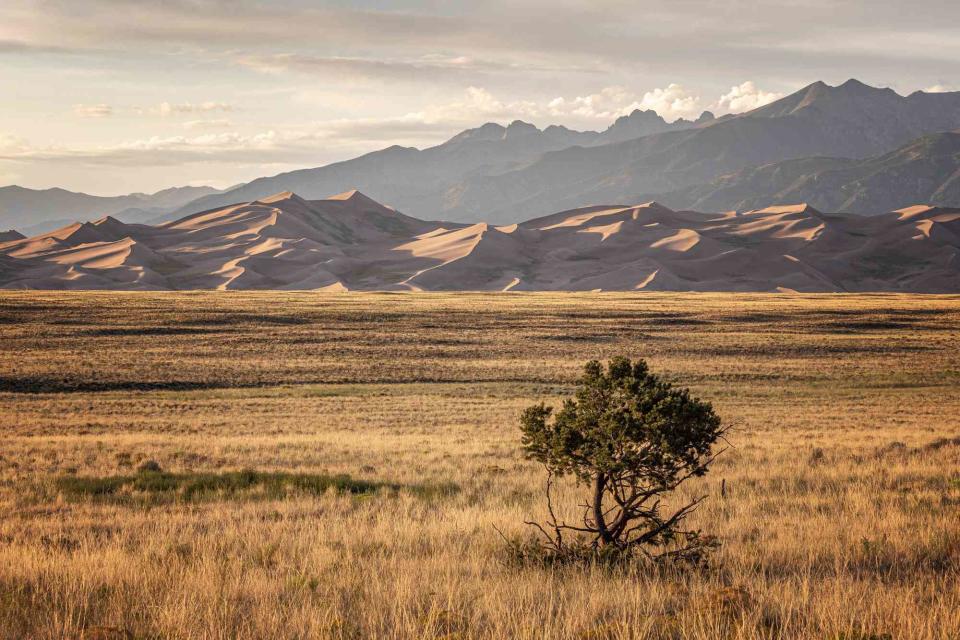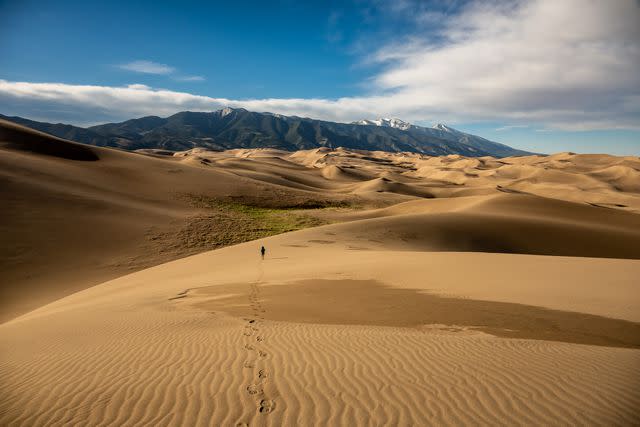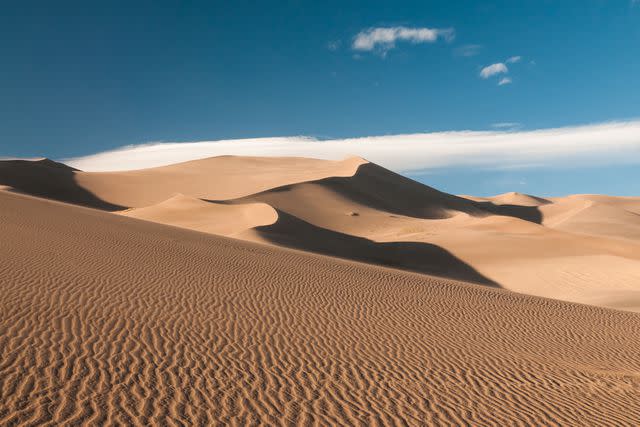This Lesser-known Colorado National Park Is Home to the Tallest Sand Dunes in North America
Here's what you need to know before visiting Great Sand Dunes National Park and Preserve in Colorado.

Guenther Reissner/500px/Getty Images
Great Sand Dunes National Park and Preserve is located where the wide-open and dry expanse of the San Luis Valley and the towering Sangre de Cristo Mountains collide.
At first glance, the Colorado national park is a strange place to find North America’s tallest sand dunes, yet it is this precise landscape that formed the towering dunes and maintains them today. According to geologists, sand blowing across the San Luis Valley was caught in the bend of the Sangre de Cristo Mountains and was met with opposing storm winds. Over time, the force of two opposing winds pushed the settled sand into the towering mountains that draw visitors today.
And while the park and preserve, which is located in southern Colorado, is known for its sand dunes, they are merely one part of a diverse landscape that includes grasslands, forests, wetlands, tundra, and alpine lakes.
To help guide your time at this enchanting national park, we’ve put together a guide that outlines where to stay, when to visit, and what things you won’t want to miss at Great Sand Dunes National Park.
Things to Do at Great Sand Dunes National Park
The dunes are the park’s main attraction, so start there. Climb the sandy peaks and then strap on your rented sandboard (or sled) and slide back down. If you happen to be on the dunes at sunset, watch the shadows get long and the color of the dunes change from a sandy gold to an orangish-coral color. The vibrant “on-fire” dunes set against the backdrop of the Sangre de Cristo mountains are a photographer’s dream. Popular dunes include Hidden Dune and Star Dune, which as of 2021 were both 741 feet high, making them the two tallest dunes in North America.
There are forested hiking trails on the edge of the dunes, including the shady Montville Nature Trail and the Mosca Pass Trail, which was used by Native Americans and early settlers to access the valley. Hikers who visit the park in late September or early October will want to walk or drive Medano Pass, which has groves of aspen trees that turn a vibrant gold in the fall.
Meanwhile, travelers who come to the park in spring and early summer will want to make time to check out Medano Creek, a seasonal stream that typically only flows between May and June. In addition to playing in the shallow waters, visitors can experience the mysterious “surge flow,” when waves ripple across the sand.
Great Sand Dunes National Park is also a wonderful place for stargazing, thanks to its quiet and remote locale (and the ability to visit the park at all hours), and activities like backpacking, horseback riding, and 4x4 driving are available.

kellyvandellen/Getty Images
Where to Stay in and Near Great Sand Dunes National Park
Travelers visiting between April and October can book a site at Piñon Flats Campground, which is located one mile north of the visitor center, near the dunes. Campsites can be reserved up to six months in advance on recreation.gov at a nightly rate of $20. There are also remote sites for backpackers.
There is no lodging within the park, but Great Sand Dunes Lodge is just south of the main park entrance and offers simple but clean motel-style rooms. Just another few miles to the south is the historic Zapata Ranch, a working bison ranch with Southwestern-style lodging and gourmet meals.
When to Visit Great Sand Dunes National Park
Great Sand Dunes National Park and Preserve sees a fraction of the visitors national parks like Yellowstone and the Grand Canyon see, which makes visiting easy. There’s no need for reservations and the park is open 24/7 year round, meaning you can come in early to catch the sunrise or stay late to enjoy the epic stargazing.
September has some of the best weather — not too hot, not too cold — and fewer crowds, making it a great time to visit. Travelers who want to play in Medano Creek should visit in late May and early June.

Magic Dreamer/Getty Images
How to Get There
Great Sand Dunes National Park is located in southern Colorado near the small community of Mosca and the larger town of Alamosa. The park is just under four hours from Denver International Airport and just over two-and-a-half hours from Colorado Springs.
The park is located in a quiet, remote part of the state and is found at the end of Highway 150. Visitors can access the park at any hour, all year round. The cost for a non-commercial vehicle to enter is $25, and the pass is valid for 7 days.
For more Travel & Leisure news, make sure to sign up for our newsletter!
Read the original article on Travel & Leisure.

